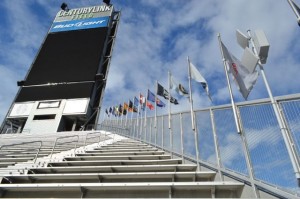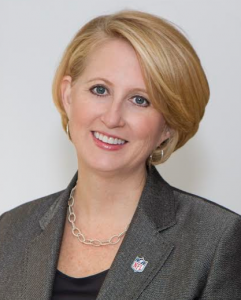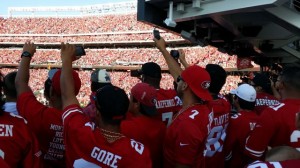In a league known for its intense rivalries, is it possible to get teams to work together and share information for the betterment of all? In the area of stadium technology, that task is on the to-do list for Michelle McKenna-Doyle, who is now in her third season as chief information officer for the National Football League.
In an interview with Mobile Sports Report, McKenna-Doyle outlined some of the league’s recent accomplishments in technology-related areas like instant replay and digital content, while also explaining how the league oversees stadium technology deployments. According to McKenna-Doyle, one of her office’s jobs is to act as a best-practices and lessons-learned clearinghouse, to better move the state of NFL stadium technology forward faster as a whole.
“One of our roles is helping teams help themselves” with technology deployment strategies, McKenna-Doyle said. “What we want is to provide a forum where clubs can share information with each other. If somebody’s done something and learned it doesn’t work, we can tell other clubs not to waste their time doing the same thing.”
The business use of technology
Focusing on the business uses of technology and not the 1s and 0s is somewhat of a natural fit for McKenna-Doyle, who spent 13 years at the Walt Disney Company in disciplines including finance and marketing before becoming a VP in IT for two years. During CIO stints at Centex Homes and Universal Orlando Resort, McKenna-Doyle said she focused on using technology to enhance the guest experience, a goal the NFL sought when it brought her aboard in September 2012.

Wi-Fi access point antennas visible on poles at CenturyLink Field, Seattle. Credit: Extreme Networks
“People really are fans of their own team first, and we encourage clubs to have that engagement, and help them interact with fans,” McKenna-Doyle said. “There are minimum standards and we do grade their [technology] experience, and report that back to the club. But they manage it. We are more of a guide.”
Putting out a plan for stadium Wi-Fi
In the area of Wi-Fi, for example, McKenna-Doyle said that last year the league put together “a really deep-dive spec” that laid out all the basics necessary for stadium Wi-Fi deployments. “That was so teams didn’t have to start at square one for design,” McKenna-Doyle said.
The league also helped move Wi-Fi deployments forward faster by signing a preferred-supplier deal with Extreme Networks, under which teams get a discount on pricing in exchange for the league-wide sponsorship exposure. (Editor’s note: This week, the league announced that Extreme is now the official Wi-Fi technology supplier for the NFL.) Though teams are not required to use Extreme’s Wi-Fi gear, new Extreme-based Wi-Fi networks are in use this season at Seattle, Jacksonville, Tennessee, and Cincinnati, joining two previous Extreme installations in Philadelphia and New England.
“It’s a great option if teams choose Extreme, and it [the league deal] also creates a competitive environment for other suppliers like Cisco to step up,” McKenna-Doyle said.
If necessary, the league can also play Wi-Fi matchmaker, as McKenna-Doyle said it did in bringing partner Verizon into Seattle, where the carrier deployed a Wi-Fi network at CenturyLink Field that is live this season.At the writing of this report, 10 of the NFL’s 32 teams still had no fan-facing Wi-Fi services at their stadiums, a list that includes Green Bay, Baltimore, Cleveland, Buffalo, Houston, Oakland, San Diego, Washington, Minnesota and St. Louis. While McKenna-Doyle said that there are “a few more Wi-Fi announcements coming,” she also noted that some teams with lease uncertanties still don’t have firm plans to deploy Wi-Fi.
Help on the app side with partner YinzCam
McKenna-Doyle said the league also provides assistance in stadium application development via YinzCam Inc., a Pittsburgh-based company that has developed mobile apps for a number of pro sports teams. The NFL, which was an investor in YinzCam, uses the company’s technology in its league mobile apps, and McKenna-Doyle said YinzCam is also developing an app for the upcoming Super Bowl XLIX that will be “like nothing we’ve ever had before.”
Though teams are not required to use YinzCam – the San Francisco 49ers, for example, turned to newcomer VenueNext to develop their Levi’s Stadium app – McKenna-Doyle said that YinzCam may be a fit for other teams.
“For quality and speed to market, [YinzCam’s] product is very strong,” McKenna-Doyle said.
It’s about the fans, not the technology
Following a summer that saw her office overseeing the new method for on-field official review of replay calls – “which meant building a new system for 32 teams, 31 stadiums, and training all the officials” – as well as the launch of the NFL Now digital content site, McKenna-Doyle is back spending time with teams, counseling them on technology deployment resource management – “what to prioritize, and what to put on the back burner,” she said.
That includes technology ideas that might not work operationally, like a food-ordering service that isn’t staffed properly. For the in-seat food ordering feature at Levi’s Stadium, for instance, the 49ers said they did extensive research, hiring and training to make sure they had enough feet on the ground – runners carrying orders – to make the tech-inspired feature work.
If teams don’t do the human engineering behind the scenes, McKenna-Doyle said, the technology may not be that cool.
“We stress that it’s not about the technology, but about the fan experience,” McKenna-Doyle said. “It has to be operationally sound, and it has to be integrated with being at the game. If it’s not something that’s operationally sound, you might be better off not doing it.”








